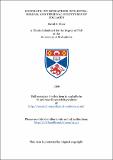Enzymatic investigations into extra-helical and terminal structures of collagen
Abstract
The presence of 0.1 - 0.2 moles of free N-terminal groups per 100.000 g. of soluble collagen was demonstrated, and it was proposed that this arises as a result of either tissue catabolism or an incomplete asking of N-terminal residues. Liberation of carbohydrate from collagen by the action of alpha-amylase, without a concomitant release of significant amounts of extra N-terminal residues, precluded the involvement of bexose as a masking factor for alpha-amino groups; although linkage of carbohydrate to E amino groups or histidine residues, is still a possibility. All of the E lysyl amino groups of collagen were demonstrated to be effectively free for substitution by the reagent 1 Fluoro 2:4 dinitrobenzene, with the reservation that one or two residues way be covalently bonded at the E amino group and so not available to F.D.H.B. The presence of free lysine in hydrolyses of D.N.P. peptides obtained by collagenase digestion of collagen, and subsequent dinitrophenyletion, was shown to be probably due to this. As more free lysine was found in analyses of material from insoluble collagen than of material from soluble collagen, it was concluded that the free lysine probably has been involved mainly in intermolecular crosslinking. Further evidence for covalently linked E-lysyl groups came from investigations on polar peptides obtained by electrophoretic separation of the collagenase-liberated peptides. It was suggested that these linkages may be involved in intermolecular crosslinking, but were not involved in intermolecular crosslinking of the type proposed by Bornstein et. Al. (1965).
Type
Thesis, PhD Doctor of Philosophy
Collections
Items in the St Andrews Research Repository are protected by copyright, with all rights reserved, unless otherwise indicated.

